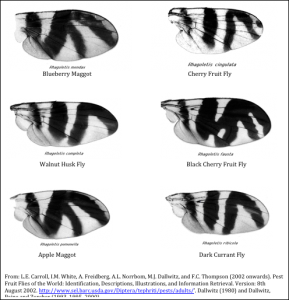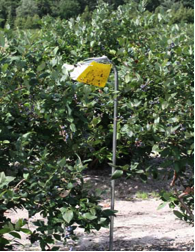The first trap capture was seen on June 7 in Burlington County which started the clock for those growers on a calendar based spray program if exporting fruit to Canada. See Fruit IPM report for this week.
- Life Cycle
- Monitoring and Management
- Adult Identification
- Control Options
Blueberry Maggot Life Cycle
There is one generation per growing season. BBM overwinters in the soil below blueberry bushes enclosed in a brown puparium buried one to two inches deep in the soil. Pupae lay dormant until environmental conditions become suitable to emerge as adults (early through mid-June). Peak emergence and migration from wild hosts continues from mid-July through mid-August. Female blueberry maggot flies do not begin laying eggs until 10 days after emergence, typically corresponding to when the blueberry fruit turns blue. Adult females live for about 30 days, feeding on nectar, dew, and honeydew. Female flies lay one egg per berry under the fruit skin, which hatches in five to seven days. Maggots feed for about three weeks inside ripening and harvested fruit. The full-grown larva is about 7/16 to ½ inch long and white. The body is tapered, with an indistinguishable head at the narrow end. As the larvae mature, infested fruit become soft and watery, and drop to the ground. The cycle is perpetuated for the following year as larvae then pupate in the soil under the bushes from which they have dropped. Pupae may remain in the soil for up to 2 to 3 years.
Blueberry Maggot Monitoring and Management
Determining the onset of adult fly activity is essential to the control of BBM as protective sprays must be applied in the 7 to 10 day period before oviposition begins.Regular monitoring of blueberry maggot emergence is done with yellow baited sticky traps. A trap and lure system has been developed that increases blueberry fly capture. Pherocon AM yellow sticky boards baited with ammonium acetate work effectively in monitoring blueberry maggot flies. Traps should be hung in a “V” orientation within the top 6-8” of the bush canopy, not above it, with the yellow surface facing down (see photos). Sometimes this means cutting away a little foliage so it doesn’t stick to the trap. If the trap is hung above the foliage then fewer to no maggot flies will be caught. The traps should ideally remain open at a 90º angle. As the trap gets wet, it looses form and gets heavier. Use of a #14 or 12 wire in place of the plastic coated wires that come with the traps will help maintain proper orientation and shape.
Traps should be placed at least a week before first flies are expected to emerge (early June). Traps should also be changed every 2 weeks, since the ammonium acetate will volatilize off the traps. Place traps on field borders near wooded areas, with a few traps in the field interior.
Adult identification
Proper identification of the BBM flies is important. There are several flies that resemble and may be confused for BBM adults. The BBM adults are identifiable by the characteristic solid “W” or “M” shape mark on their wings. In most cases, this looks identical to apple maggot but assume that if it is in a commercial blueberry field, then it is BBM. See illustrations from Carroll et al. (2002).
Blueberry Maggot Insecticide Options
| Material | Rate/A | REI | PHI | Rating |
| Diazinon 50W | 1 lb | 5 days | 7 days | G |
| Imidan 70WSB | 1.33 lb | 24 hr | 3 days | E |
| Lannate 90SP | 1 lb | 48 hr | 3 days | G |
| Malathion 8 | 1.5 pt | 12 hr | 1 day | G |
| Sevin 80WSP /4F | 1.5 lb / 3 pt | 12 hr | 7 days | G |
| Asana XL | 8 oz | 12 hr | 14 days | G |
| Danitol | 10 2/3 – 16 oz | 24 hr | 3 days | G |
| Hero | 4 – 10.3 oz | 12 hr | 1 day | G |
| Admire (Imidacloprid) | 6–8 oz | 12 hr | 3 days | G |
| Actara | 4 oz | 12 hr | 3 days | G |
| Assail 30SG | 4.5 – 5.3 oz | 12 hr | 1 day | E |
| Rimon | 20-30 fl oz | 12 hr | 8 days | G |
| Delegate | 6 oz | 4 hr | 3 days | F |
| Surround | 25 lb | 4 hr | day of harvest | suppression |
| Entrust | 2 oz | 4 hr | 3 days | suppression |
| GF120 | 20 oz | 4 hr | day of harvest | F |
| E=excellent, G=good, F=fair, suppression=suppression only Assail, Admire, Actara, Rimon, and Delegate are reduced-risk/OP replacement products. Surround, Entrust, and GF120 are organically-approved insecticides. |
||||



